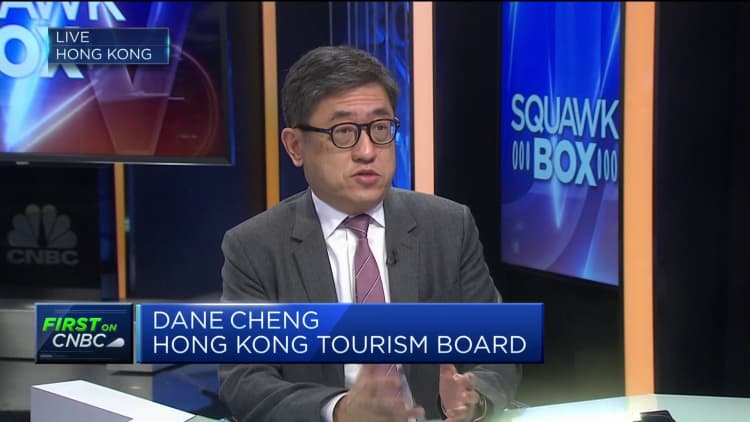Guests posing for a group photo at the “Let’s Go the Extra Mile” hospitality campaign launch ceremony at the Central Government Office in Hong Kong on June 3, 2024.
Nurphoto | Nurphoto | Getty Images
Hong Kong is asking service workers to be more courteous and smile in a bid to win back tourists. But high prices and competition from an ascending Shenzhen are bigger issues, experts say.
Long revered for its luxury shopping, restaurants and nightlife, the glitzy financial hub has yet to see visitor numbers recover to levels seen prior to years of disruptions from social unrest and the Covid-19 pandemic.
In response, the Hong Kong government launched a campaign – titled “Let’s Go the Extra Mile” – encouraging frontline staff and members of the public to demonstrate good hospitality and “reinforce Hong Kong’s brand as the best tourism destination.”
Speaking at a press conference last week, Chief Executive John Lee urged residents to be more courteous, to smile more and to “go the extra mile to promote Hong Kong’s hospitality.”
The initiative comes after data showed 24 million total visitor arrivals in the first four months of the year, still at only 60% of the level from the same period in 2019.
Though those numbers marked a significant increase from the previous year, experts warn that full recovery faces greater barriers than grumpy Hong Kongers.
Strong dollar, high prices
“One of the biggest problems for the city is simply that we’re expensive,” said Allan Zeman, chairman of Lan Kwai Fong Group, the major property owner and developer in Hong Kong’s iconic Lan Kwai Fong nightlife district.
Hong Kong’s currency is pegged to the U.S. dollar, which has helped the city’s status as an international financial center. However, this can also make it pricey compared to many other Asian economies, especially now amid high interest rates and a strong U.S. dollar.
“Tourists are finding that other places like Shenzhen and Japan are very, very cheap in comparison,” said Zeman, who also acts as an advisor to the Hong Kong government.
This dynamic is especially true for mainland Chinese travelers — with the Chinese yuan depreciating significantly against the U.S. and Hong Kong dollars in recent months.

At the same time, Zeman said mainlanders are making up a larger share of tourists in the city as other nationalities have been slower to return. He said this poses a problem for local businesses as mainlanders tend to spend less due to travel preferences, shorter stays and tighter budgets amid economic troubles at home.
While Hong Kong’s Culture, Sports, and Tourism Bureau projects the number of tourists to increase this year, it estimated per capita expenditure by overnight visitors to drop to 5,800 Hong Kong dollars ($742.64), down from last year’s HK$6,939, according to figures released in the 2024 budget.
LKF, a popular destination among tourists, was particularly hard hit when Hong Kong’s borders were closed during the pandemic.
While Zeman says many of the neighborhood’s businesses have recovered strongly, there are currently some unused spaces — once a rare occurrence during pre-pandemic times.
Hong Kongers leave for bargains
Conversely, locals are increasingly taking trips to the neighboring mainland city of Shenzhen, according to economist Simon Lee Siu-Po, an honorary fellow at the Asia-Pacific Institute of Business at the Chinese University of Hong Kong.
“Both have become equal problems for Hong Kong,” he said.
While the city’s borders were closed during the pandemic, nearby Shenzhen continued to develop into a top-tier Chinese city, Lee said. And newly built high-speed rails and a mega cross-sea bridge have made that journey more convenient than ever.
Shenzhen offers a wide range of food, entertainment and shopping options that can now compete with Hong Kong, said Lee, adding that prices for goods and services in the city are sometimes up to two or three times cheaper.
This dynamic explains why thousands of Hong Kongers flocked to the Shenzhen border for the Easter holiday in late March, leaving the financial hub’s restaurants, bars and shopping centers empty, according to local media.

For the entire month of March, the city of 7.3 million people saw 9.3 million residents depart from its passenger traffic control points. Government data shows this was the single-highest monthly number of departures since at least 1997 when the city was handed over from British rule to Chinese sovereignty.
Meanwhile, only about 3.4 million visitors entered the city that same month.
These trends have taken their toll on Hong Kong businesses, with retail sales continuing to fall as local media reports on rapid rates of restaurant closures.
According to a recent survey conducted by the Hong Kong Small and Medium Enterprises Association, 70% of local small and medium-sized firms in the city reported a decline in business performance compared to pre-pandemic levels.
In addition to campaigns like “Let’s Go The Extra Mile,” Hong Kong authorities have also set aside HK$1.09 billion for citywide events like firework shows to boost tourism and spending.
While the funds will help, combating high prices and competition from Shenzhen will require much more drastic efforts, said Lee and LKF’s Zeman.
Credit: Source link















